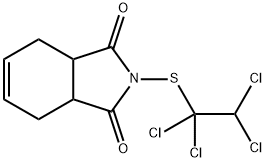캡타폴 C화학적 특성, 용도, 생산
화학적 성질
Captafol is a white crystalline solid.
용도
Captafol is used to control a wide range of fungal diseases on
many crops.
정의
ChEBI: A dicarboximide that captan in which the trichloromethyl group is replaced by a 1,1,2,2-tetrachloroethyl group. A broad-spectrum fungicide used to control diseases in fruit and potatoes, it is no longer approved for use in the European Community.
일반 설명
White crystalline solid with a slight, but pungent odor. Mp: 162°C. Practically insoluble in water. Only slightly soluble in organic solvents. Technical CAPTAFOL is a wettable light tan powder that is used as a fungicide. Inhaled dust irritates the respiratory tract. Irritates skin and damages eyes. Acute oral toxicity in humans is low. Not persistent in the environment (decomposes with a half-life of 11 days in the soil). Highly toxic to fish and other aquatic organisms.
반응 프로필
CAPTAFOL is non-flammable but, on heating, may decompose to generate toxic fumes, such as sulfur oxides, hydrogen sulfide, hydrochloric acid, and phosgene. Stable at room temperature when dry but readily hydrolysed, especially in an alkaline environment. CAPTAFOL and mixtures containing high concentrations of CAPTAFOL may react violently with alkali. Incompatible with acids, acid chlorides, acid anhydrides, and strong oxidizing agents. Sulfhydryl compounds such as glutathione and cysteine cause a rapid chemical decomposition.
위험도
Absorbed by skin. Probable carcinogen.
농업용
Fungicide: Captafol is a General Use Pesticide and used for the control of practically all forms of fungal diseases except powdery mildew. It is also used as a seed protectorant on cotton, rice and peanut crops. Not registered for use in the U.S. or in EU countries. There are 20 global suppliers.
상품명
CAPTATOL®; CAPTOFOL®; CRISFOLATAN®; DIFOLATAN®[C]; DIFOCAP®[C]; DIFOSAN®; FOLCID®; HAIPEN®; KENOFOL®; MERPAFOL®; ORTHO® 5865[C]; PILLARTAN®; SANSEAL®; SANSPOR®; SANTAR-SM®; SULFONIMIDE®; SULPHEIMIDE®
색상 색인 번호
Captafol is a pesticide, belonging to thiophthalimide
group. Occupational contact dermatitis was reported in
an agricultural worker who had multiple sensitizations
Safety Profile
Confirmed carcinogen
with experimental carcinogenic data. Poison
by intraperitoneal route. Moderately toxic by
ingestion. An experimental teratogen. Other
experimental reproductive effects. Mutation
data reported. A fungicide. When heated to
decomposition it emits very toxic fumes of
Cl-, NO,, and SOx
잠재적 노출
Captafol is a thiophthalimide fungicide. Those engaged in the manufacture, formulation, and
application of this fungicide. Captafol is not currently registered for use on field crops or stored produce in the
United States.
Carcinogenicity
Captafol is reasonably anticipated to be a human carcinogen based on sufficient evidence of carcinogenicity from studies in experimental animals and supporting data on mechanisms of carcinogenesis.
환경귀착
The primary toxicity following captafol exposure probably
occurs through a hypersensitivity mechanism. Most experiments
suggest captafol to be DNA active.
신진 대사 경로
Captafol contains an unstable tetrachloroethylthio (sulfenyl) moiety that
has been shown to undergo rapid hydrolytic and metabolic degradation
to tetrahydrophthalimide (2). By analogy with captan, presumably the
tetrachloroethylthio moiety can be transferred to the sulfur atoms of
thiols such as cysteine and glutathone. Thus in the presence of thiols
such as glutathione, captafol is probably cleaved at the N-S bond to
form thiophosgene (3) and other gaseous products such as hydrogen
sulfide, hydrogen chloride and carbonyl sulfide. Thiophosgene is rapidly
hydrolysed by water. The tetrachloroethylthio group and thiophosgene
are believed to be intermediates in the formation of thiazolidine-2-
thione-6carboxylic acid (4) which is an addition product with cysteine. A
thiazolidine derivative of glutathione is also formed (5). Biotransformation
of captafol in mammals generates primarily thiophosgene (3)
and tetrahydrophthalimide (2). Tetrahydrophthalimide (2) and various
of its derivatives are excreted in the urine. There were no reports of
2-thiazolidinethione-4-carboxylic acid (4) in the urine.
운송 방법
UN2811 Toxic solids, organic, n.o.s., Hazard
Class: 6.1; Labels: 6.1-Poisonous materials, Technical
Name Required. UN 2773 Phthalimide derivative pesticides, solid, toxic, Hazard Class: 6.1; Labels: 6.1-Poisonous
materials, Technical Name Required.
비 호환성
Reacts violently with bases, causing fire
and explosion hazard. Not compatible with strong acids or
acid vapor, oxidizers. Strong alkaline conditions contribute
to instability. Attacks some metals.
폐기물 처리
Hydrolysis.
캡타폴 준비 용품 및 원자재
원자재
준비 용품








